Hosted by Nanette Masi
When my husband Mike and I purchased our two-acre property in 1994, the landscape was overrun with invasives, including Japanese knotweed, honeysuckle, barberry, burning bush, and more. Yet, the distinctive features of the site were well worth a decades-long struggle to replace invasives with native and sustainable plantings. Almost an acre of freshwater tidal marsh covers the western portion of the property and attracts a wide variety of marsh creatures and water-loving birds, including great blue herons and kingfishers. A shady stream meanders and gurgles along the eastern border beneath towering maple and hickory trees. Across the street, the bank of the Merrimack River is trimmed with river birches and young oaks.
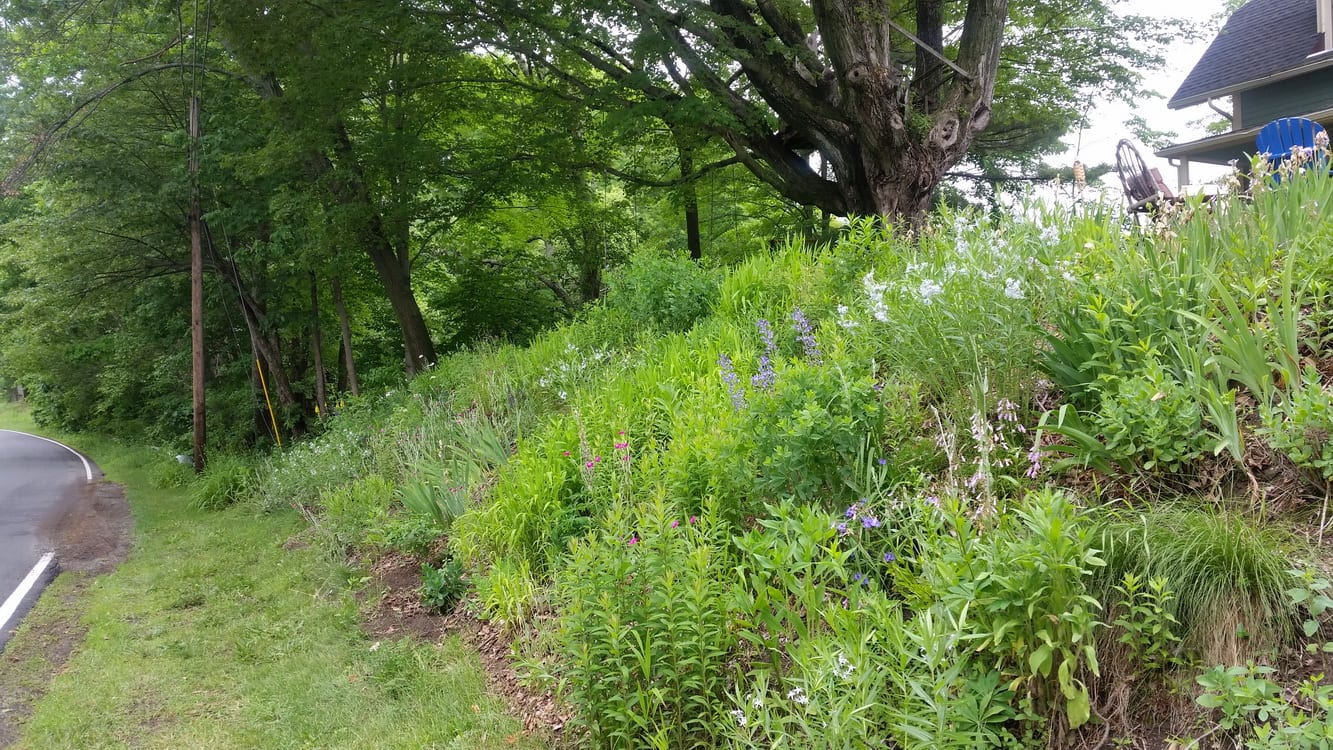
A hillside meadow drops from the front of the yard to the road.
The house is set upon a knoll with a steep slope down to the road. In front of the house, a 150-year-old sugar maple holds its limbs up to the sky as if it were a giant hand rising to heaven. The steep slope is thick with grasses and wildflowers, all competing for space. Purple lupines, baptisia, and tickseed begin the bloom sequence, followed by waves of coneflower, sage, sedums, goldenrod, asters, switch grass, and northern sea oats. An ongoing struggle ensues with the original crown vetch and nonnative grasses.
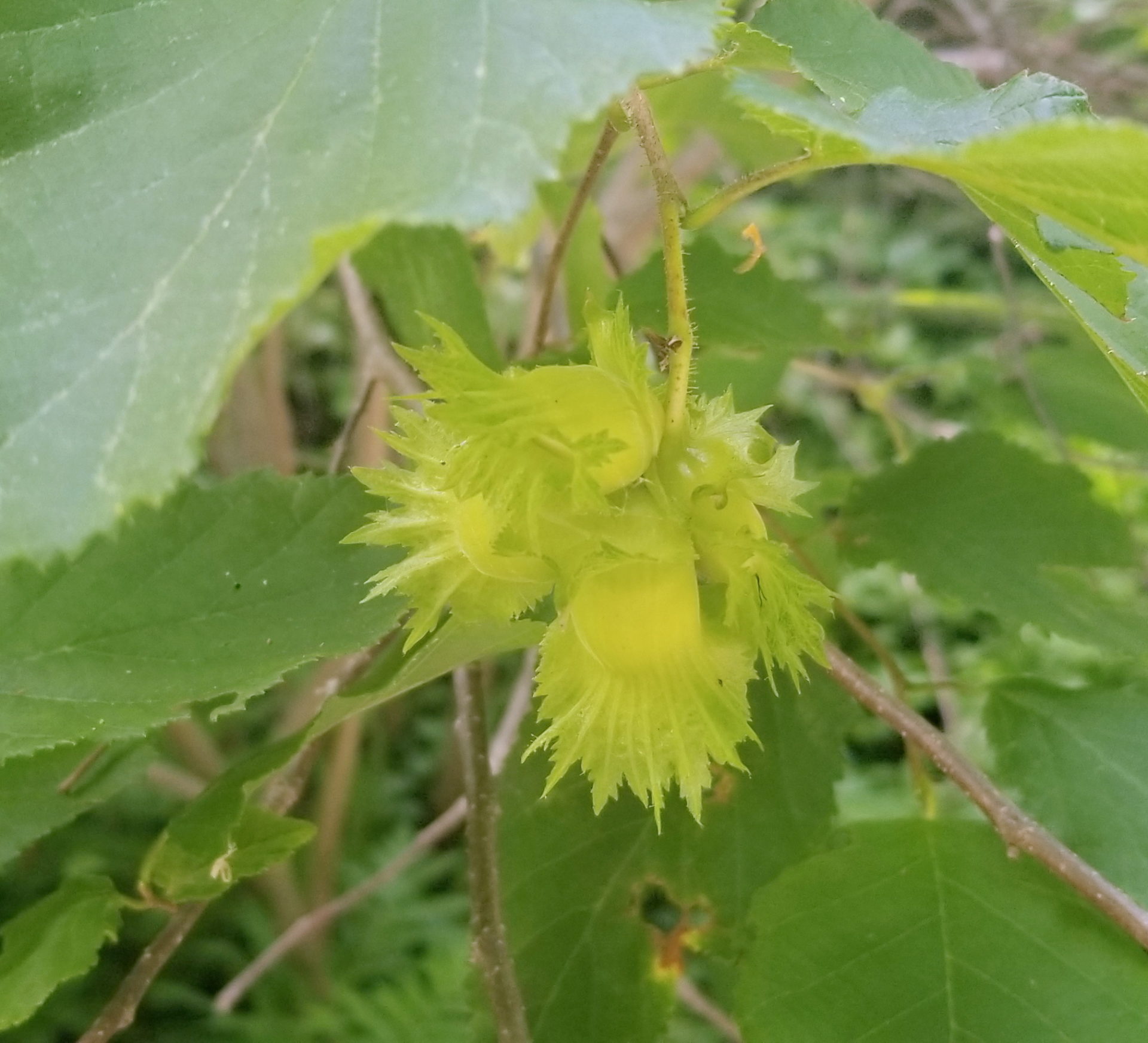
The seeds of hazelnut (Corylus americana)
A diversity of trees and shrubs line the narrow, curving driveway, each taking a turn in the spotlight as the season progresses and offering a wide selection of berries for birds and wildlife. The scented white bells of andromeda appear first, along with bright, red-orange quince blossoms and buttercup-yellow Japanese kerria. A striped maple dangles 2-3″ long, lime-green catkins from its branches in the shape of mini rain chains. American hazelnuts promise small, edible nuts encased in frilly, leafy husks in late summer. Soon after, creamy-white flower clusters cloak beachplums and a wild crabapple, complementing the rosy-pink blossoms of a cherry tree, intermingling their sweet fragrances.
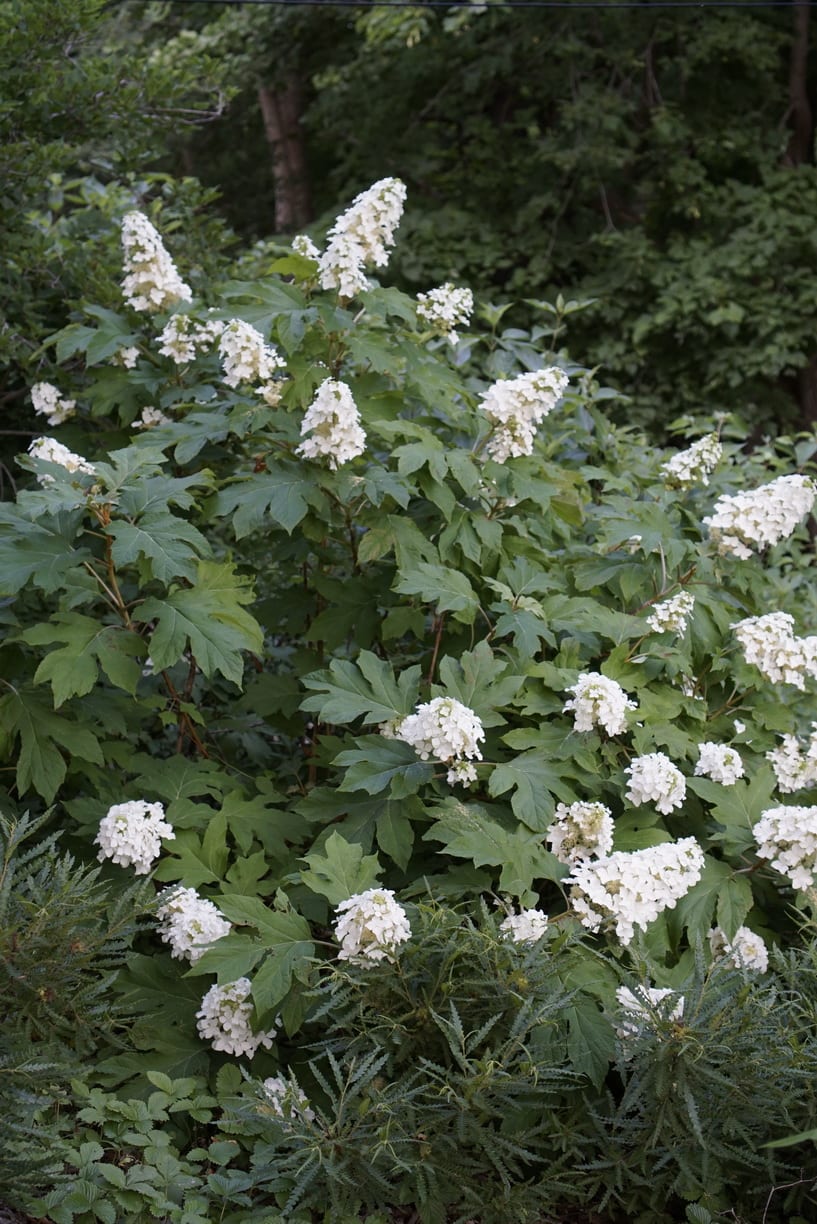
Oakleaf hydrangea in bloom (H. quercifolia)
Arching over the driveway, a flowering dogwood blooms next, its wide blossoms clinging to the branches like clusters of white butterflies. Dainty, drooping bells of redvein enkianthus appear in peachy-pink masses. Later, redtwig dogwoods, gray dogwoods, and winterberries begin their own bloom cycles. At the top of the slope, waxy berries of scented bayberry await migrating birds. An oakleaf hydrangea holds the promise of dramatic summer flowers that transform from crisp white to hazy pink by autumn. Lowbush blueberries are interplanted with butterfly weed that later bursts into orange bloom.
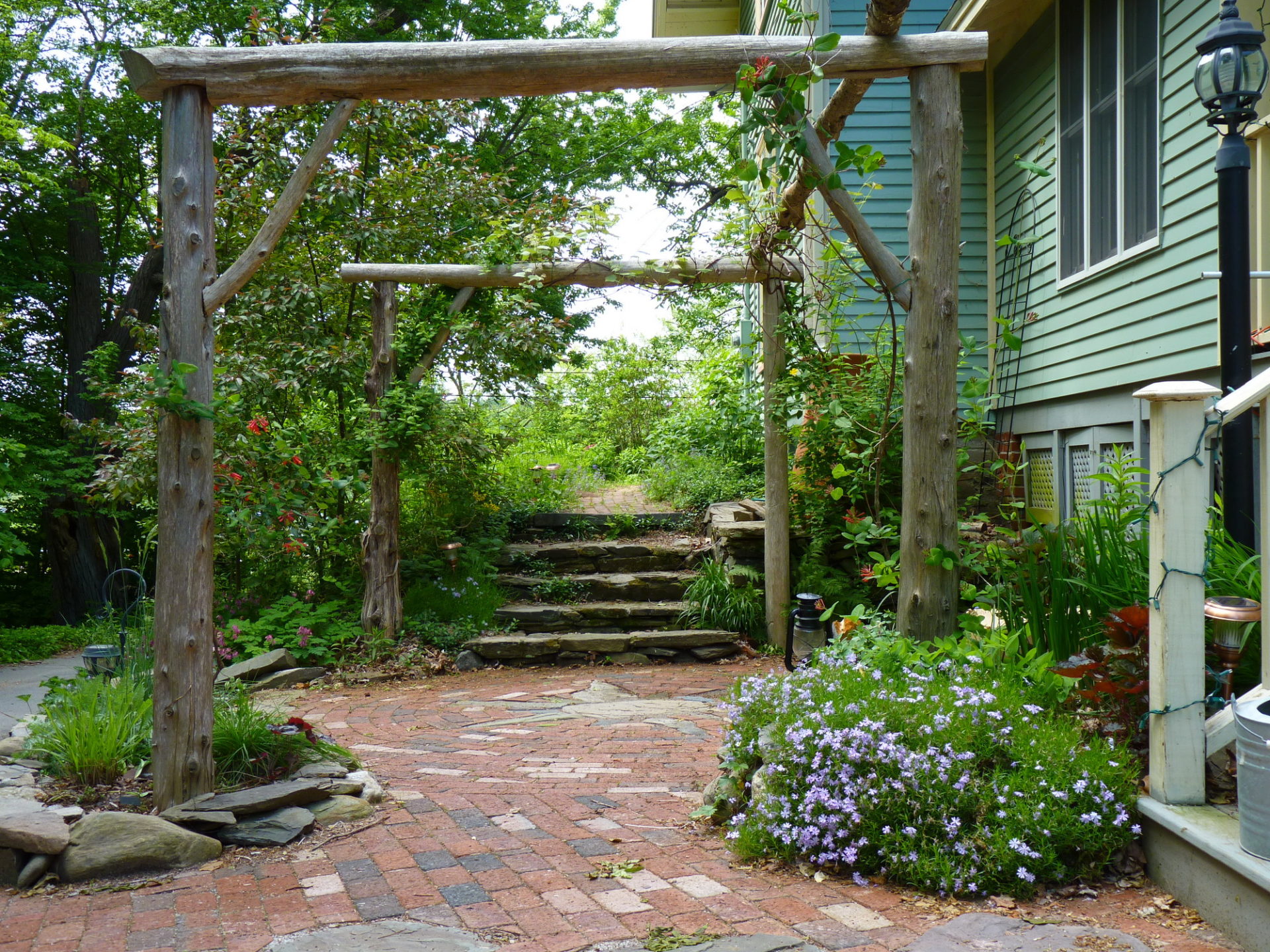
Just off the driveway, a brick patio features a sunburst pattern.
Just off the drive, a small brick patio with stone insets in the shape of a sun sits beneath an open pergola, creating an intimate space. Honeysuckle, clematis, and grapevines creep up and across the cedar posts. The tubular red flowers of the native honeysuckle vine are a favorite with hummingbirds. Water splashes from a frog fountain in a repurposed enameled kitchen sink.
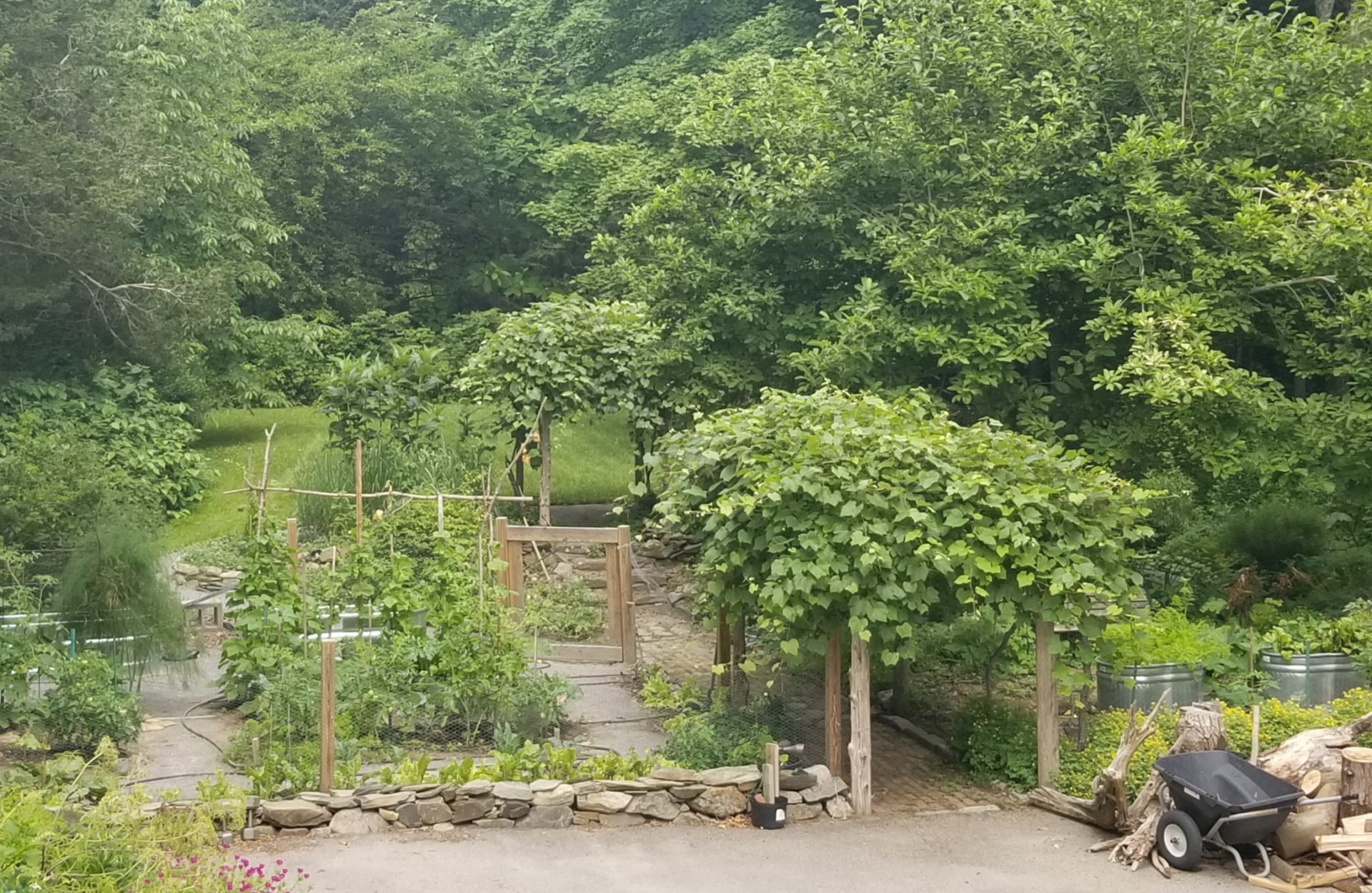
At the top of the driveway, visitors pass through a small vegetable garden to lawn bordered by native understory trees.
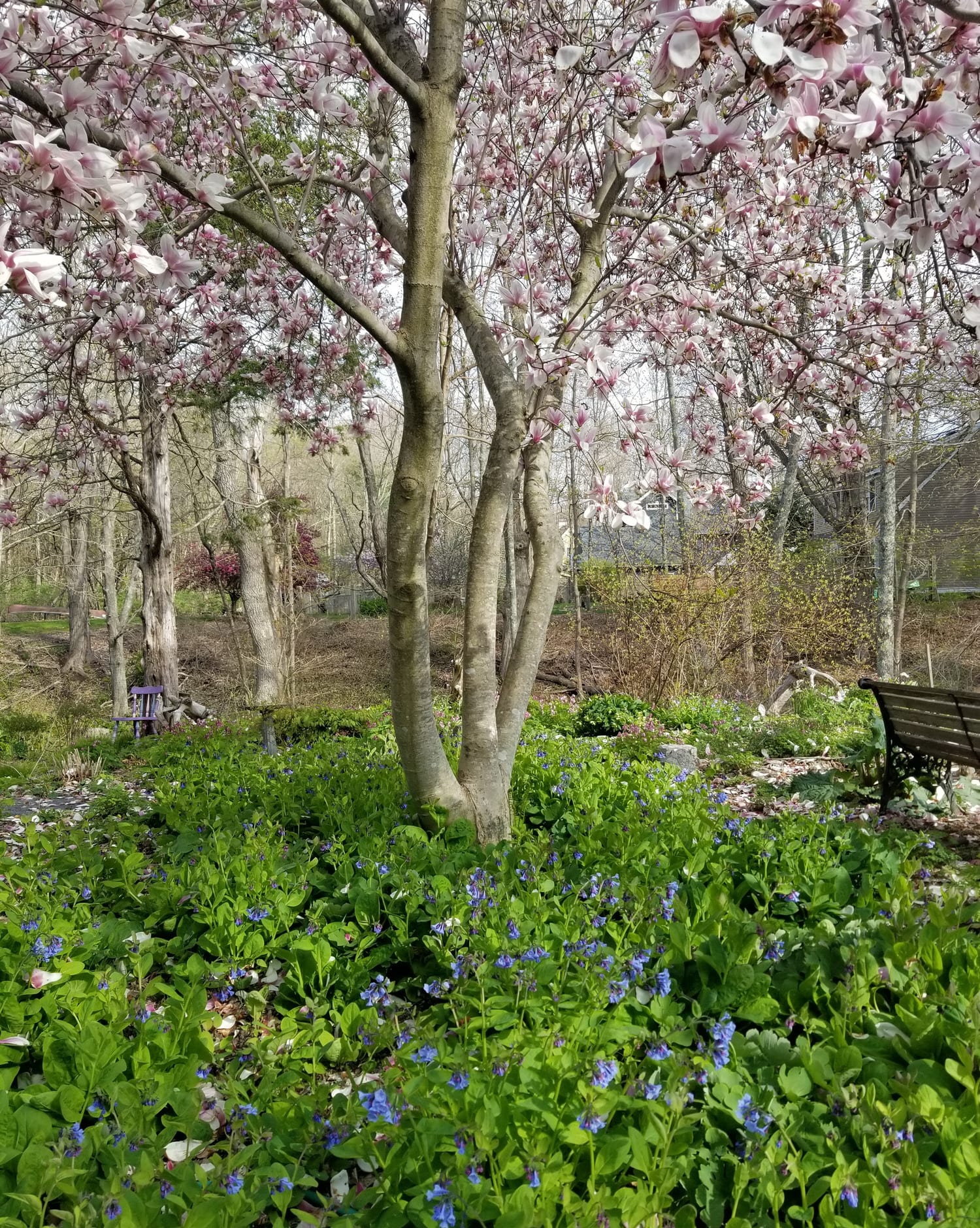
Virginia bluebells encircle the mature saucer magnolia (M. soulangiana).
From the parking area at the top of the driveway, a short, brick path leads beneath a cedar arbor tangled with grapevines to the back lawn. To the left is a small, fenced-in vegetable garden. To the right, two galvanized troughs are planted with carrots and greens. A mature saucer magnolia spreads its branches over a shady wildflower patch. In early spring, bloodroot makes its way through the leaf cover with cheerful white blossoms that close at night, wrapped like monks in leafy robes. Soon after the bloodroot fades, Virginia bluebells crowd the space, their periwinkle blue flowers in perfect harmony with the giant pink magnolia blossoms.
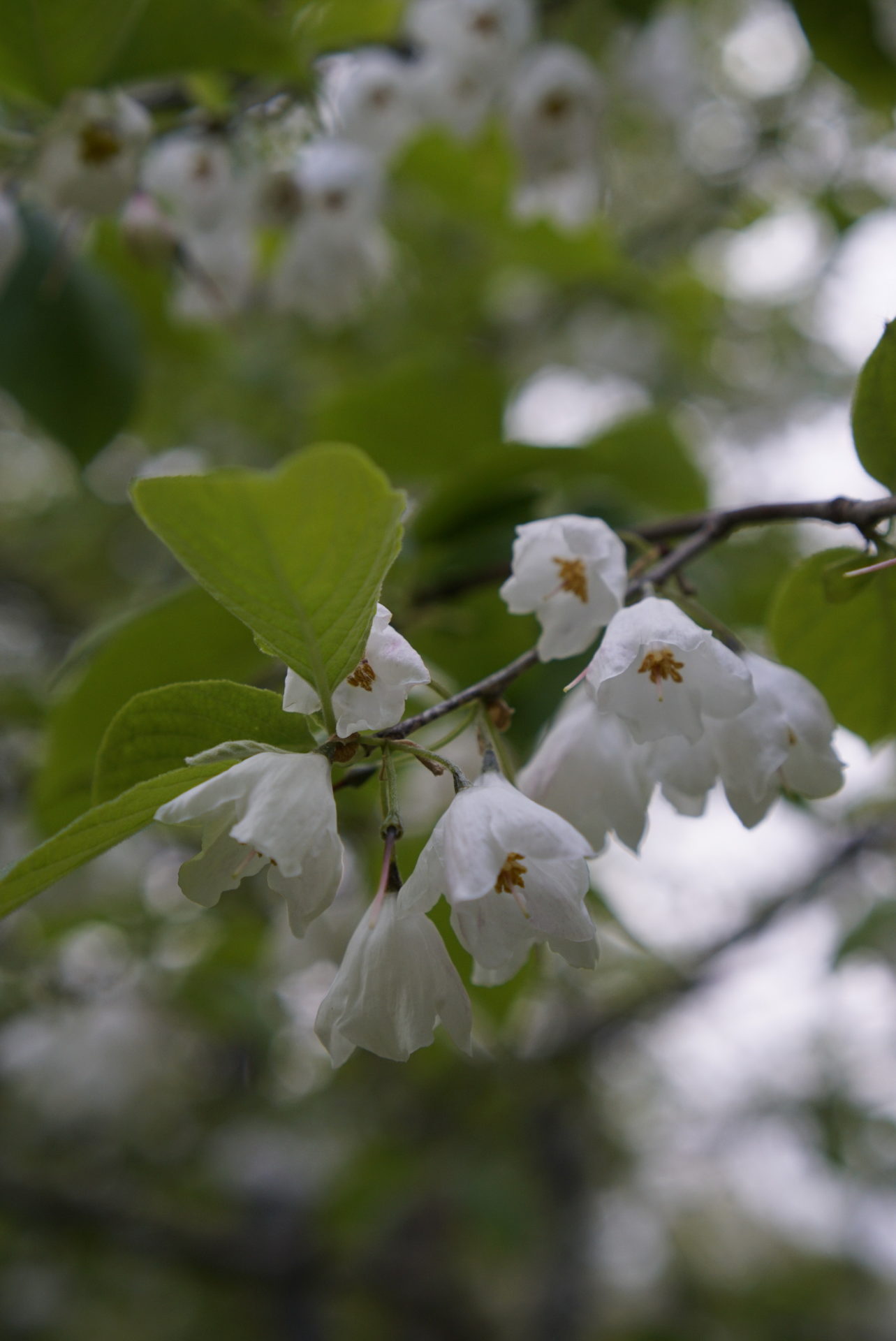
Carolina silverbell (Halesia carolina) features delicate bell-like blossoms.
Unique understory native trees encircle the lawn, backed by mature hemlock and maples. Underplanted with shrubs, they provide valuable edge habitat. To the rear, a majestic umbrella tree rises from a wild blackberry thicket. A native magnolia, its huge cream-colored flowers hover over jungle-like giant leaves (up to 2 feet long) that cluster at the tips of the branches. The flowers fade to yellow before growing 4-6” showy seed pods with bright red fruit. A pair of tall, shade-tolerant Pawpaw trees planted a decade ago (still to bear fruit) offer narrow silhouettes with elliptical, dark glossy leaves. Their young root suckers push their way up through a gathering of mayapples, creating a close-knit colony. A Carolina silverbell shows off white strings of bells, with inkberry, azaleas, and Carolina allspice beneath its outstretched limbs.
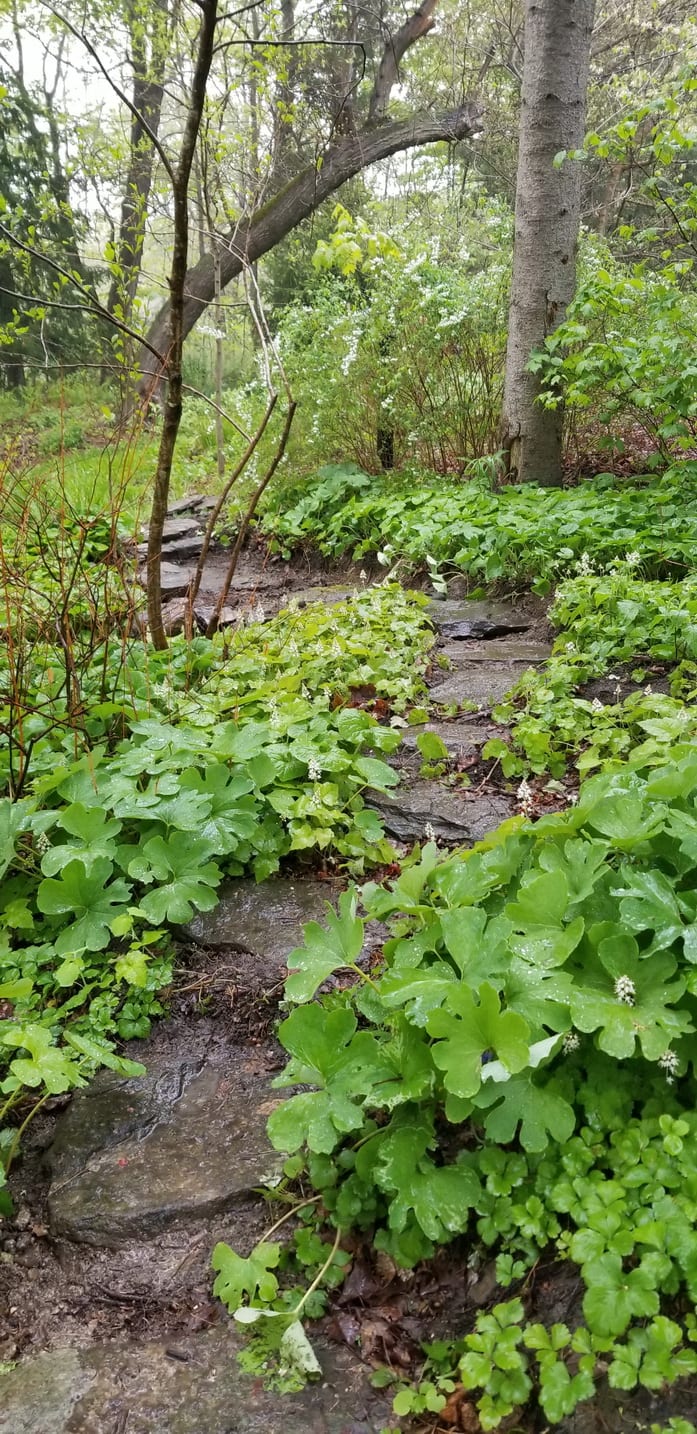
A stone path meanders through the woodland garden.
In the deep shade of giant maple trees that border the tidal marsh, a firepit garden nestles behind the Carolina silverbell and mature red cedars. A short stepping-stone path through the garden mirrors the curve of the firepit. A clonal bottlebrush buckeye anchors the lower slope of the garden. Its wide compound leaves clothe an umbrella-like shape. Fluffy white flower clusters grow up to 12” long and bloom in July, attracting hordes of swallowtail butterflies. Common witch-hazel takes the center, offering hidden glimpses of delicate, strappy yellow flowers behind its leaves in late fall. In early summer, a colony of Virginia sweetspire are covered with drooping clusters of white, fragrant flowers. Groundcovers include barren strawberry, wild ginger, ferns, and foamflower.
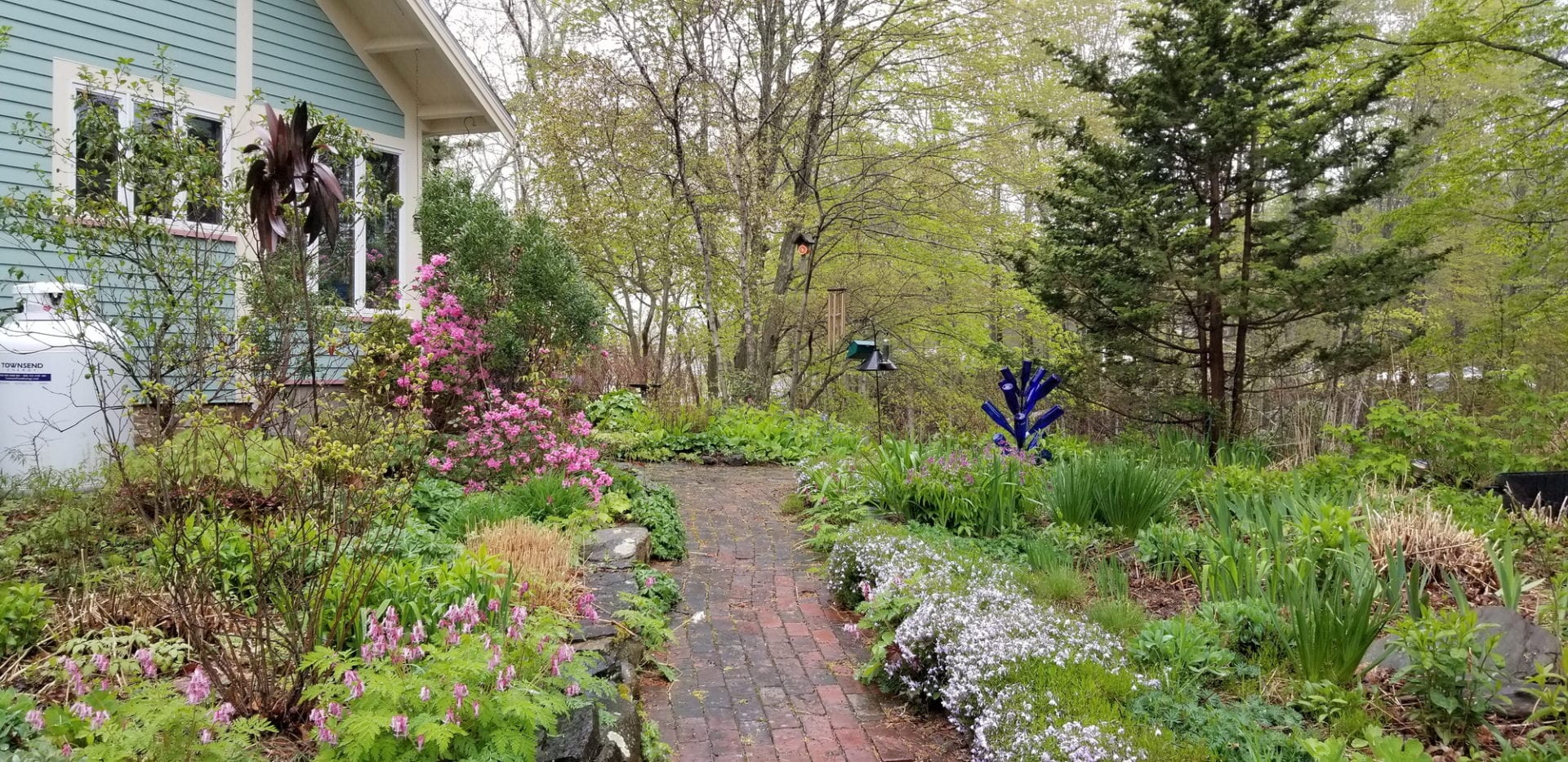
Biodiversity is the hallmark of the gardens connected by brick walkways near the house.
A series of garden areas with varying sun exposures surround the house, connected by a brick walkway. The part-shade mudroom entry is flanked by a ‘Brandywine’ possomhaw viburnum. The foundation garden on the northern side of the house includes several cultivars of mountain laurel, an inkberry, chokeberry, and fothergilla. Wild ginger, cranesbill, Jacob’s ladder, and bugbane flourish.
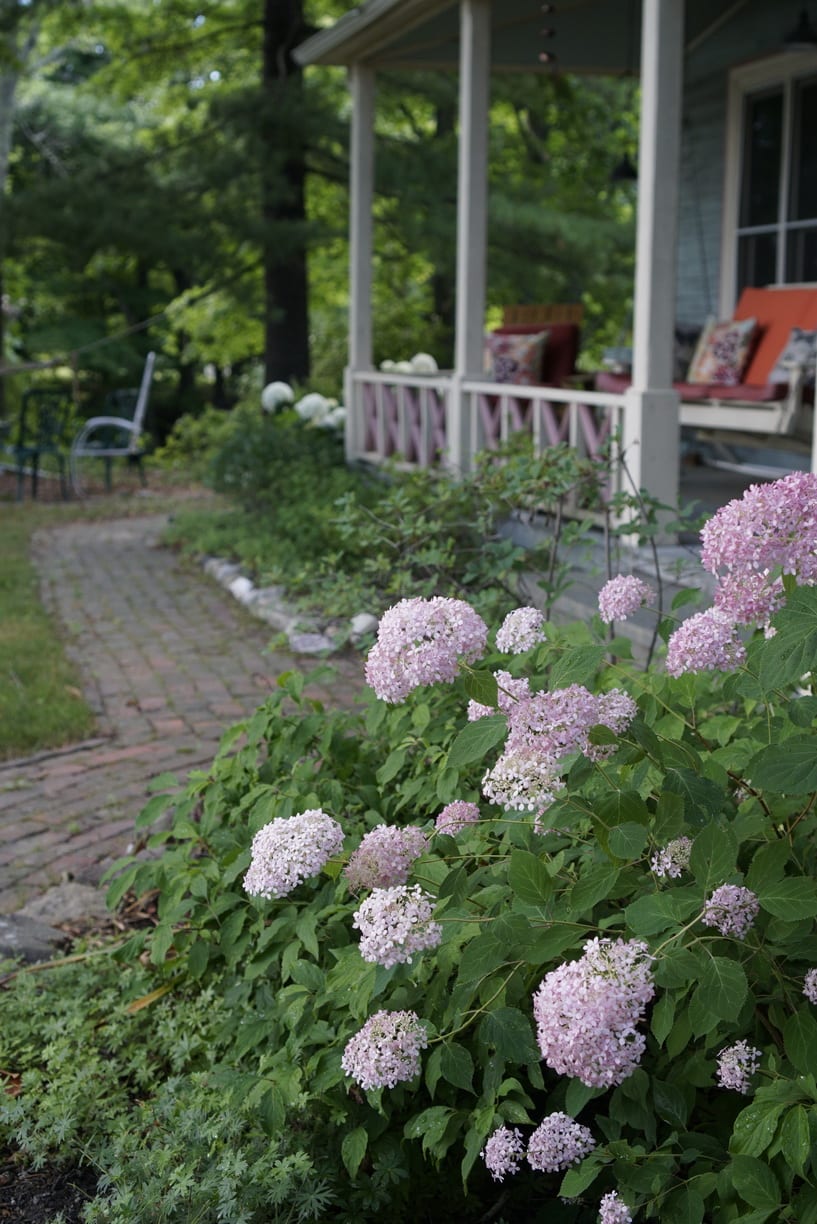
Hydrangea anchors the front porch with H. arborescens ‘Bella Anna’ in the foreground and ‘Annabelle’ at the far corner.
Along the eastern, sunnier side of the house, a newly planted row of scented-leaved sweetfern edges the foundation. A dwarf oakleaf hydrangea sits opposite clonal colonies of bayberry and Virginia sweetspire.
In front, to the right of the porch, sweetly scented coastal azaleas bloom in late spring, An airy ‘Ruby Spice’ sweet pepperbush offers fragrance and pink blossoms in July. Several ‘Arctic Fire’ red twig dogwoods provide winter interest. Sweet woodruff, ginger, and coral bells co-mingle. In front of the porch beneath the dense shade of the sugar maple, dwarf ‘Kelseyi’ redtwig dogwoods and pink rosebud azaleas thrive. Around the corner, a cluster of smooth ‘Annabelle’ hydrangeas bloom profusely from mid to late summer, their ball-like florets shifting from greenish hue to pure white.
A peastone firepit with a colorful circle of Adirondack chairs is set in the small lawn between the house and the hillside, overlooking the Merrimack River. Dwarf fothergilla, Virginia sweetspire, and the stump of an old ash tree provide cover on one side. The fire pit is a favorite gathering space for friends and family.
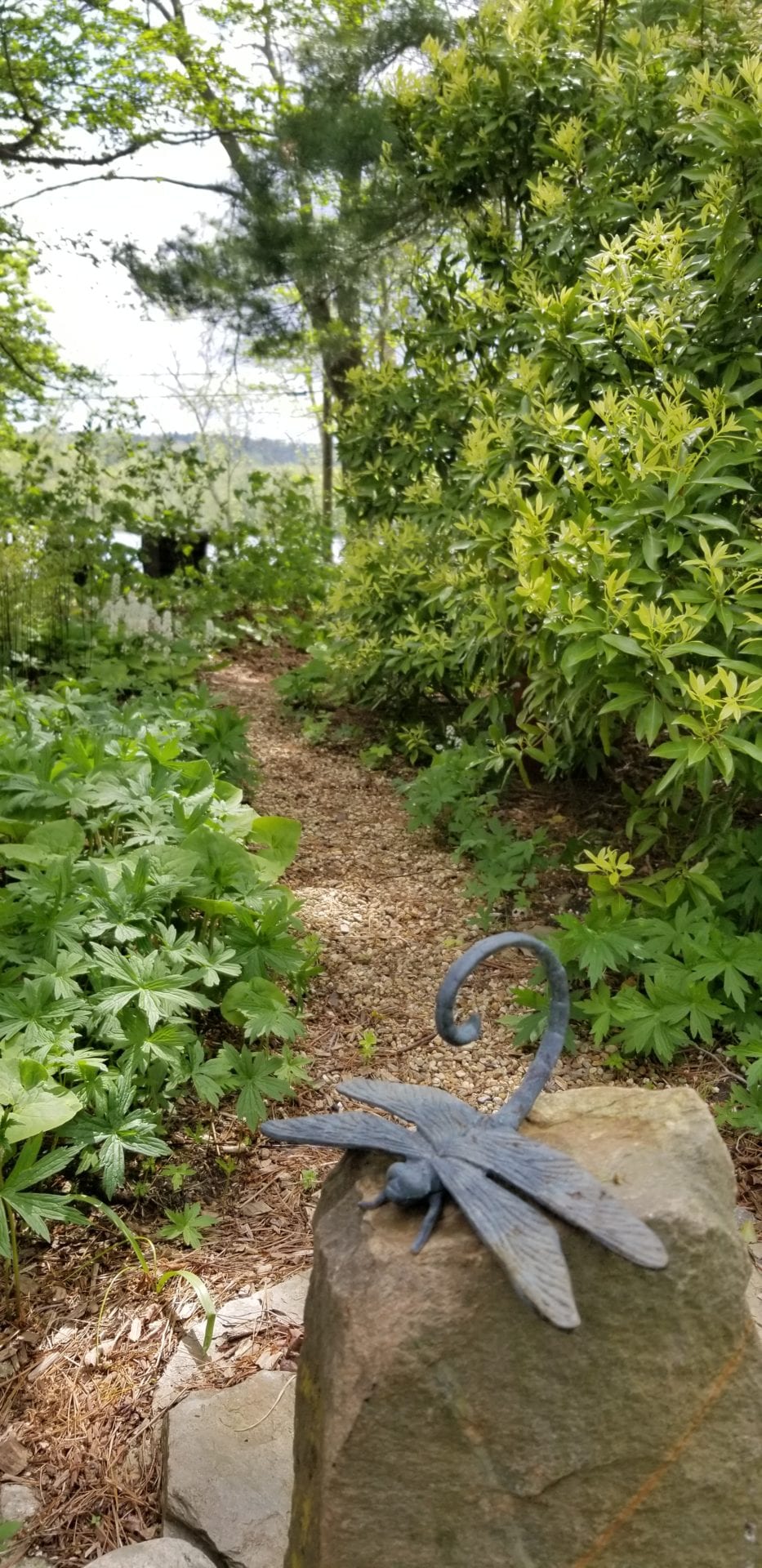
West of the house, a path leads down to a marsh.
A mature white pine stands on the west edge of the knoll where the slope leads down to the marsh. Mountain laurels and rhododendrons dot the slope. Nearby, a ‘Jelena’ witch-hazel (nonnative) offers glowing, copper-colored flowers like skinny streamers along its branches in late winter. Beneath the pine, a group of mapleleaf viburnums have spread to a pair of mature ‘Brouwer’s Beauty’ pieris. An aged white-flowering dogwood rises above the pieris with a ‘Cherokee Princess’ flowering dogwood beneath it. The Cherokee Princess was planted 15 years ago in anticipation of the white flowering dogwood’s demise. The white dogwood still blooms today above the blushing blossoms of the Cherokee Princess, an unexpected and beautiful pairing.
A raised bluestone patio seating area with a view to the marsh below is edged with sweetfern, dwarf winterberry, and ‘Hummingbird’ sweet pepperbush. Across from the patio, a short stepping-stone path leads through a pet memorial garden to a micro-patio overlook, complete with rustic chair crafted by Mike. The path passes beneath a ‘Leonard Messel’ magnolia. Canada anemone, lungwort, wild ginger, and foamflower line the path and ostrich fern clusters below. At the side of the patio, a triple-stemmed grey birch by the bird feeders serves as a popular perching site. A honeysuckle vine makes its way up one of the trunks. Trillium, maidenhair fern, royal fern, bloodroot, and monkshood fill the tiny, surrounding garden.
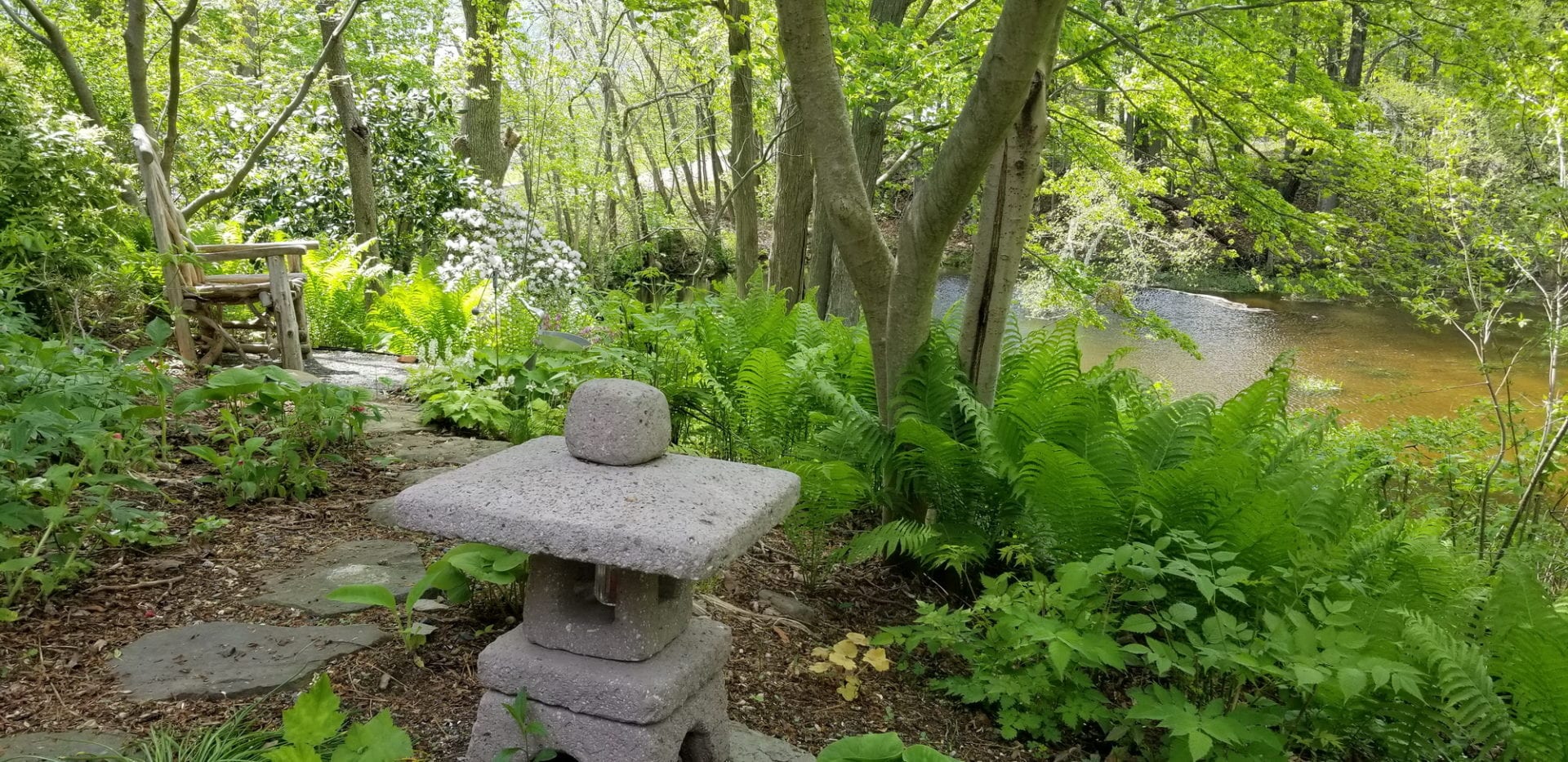
A small memorial garden dedicated their 18-year-old dog, Flash, includes Canada anemone, lungwort, wild ginger, and foamflower (lining the path) and clusters of ostrich fern.
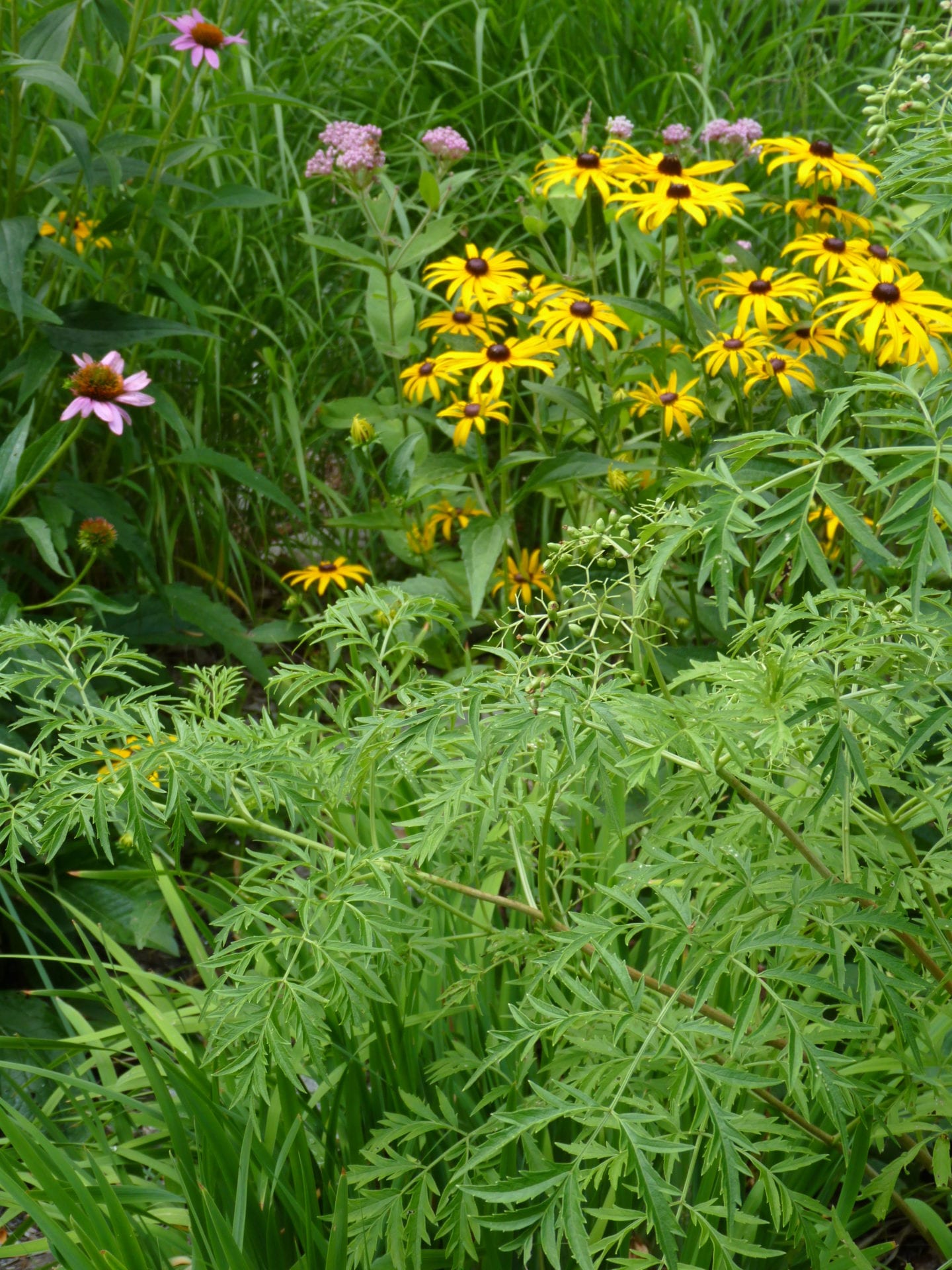
Lacy elderberry (Sambucus candensis ‘Lacinat’) floats above a mix of sun-loving perennials.
Further, along the brick path by the small greenhouse, a mature Hinoki false cypress stands beside a spreading patch of sticky-stemmed flowering raspberry whose hairy fruit is best left for the birds. Atop tall, sturdy stems, the cheerful sunflowery-yellow blossoms of cup plant draw masses of bees and butterflies in late summer. In front of the greenhouse, a sunny perennial garden bed centers around an arching ‘Lacinata’ elderberry. A mishmash of switchgrass, flag iris, cranesbill, bearberry, prairie dropseed, moss phlox, tall phlox, Joe Pye-weed, sage, purple coneflower and a variety of creeping sedums provide season-long color and interest.
A secretive wildflower garden path may be discovered off the driveway by the street. The narrow path passes a striped maple on its way down along the stream. The path sets gently into the slope, following the contours of the stream. A smattering of white, red, and yellow trillium species blooms each spring, a gift from a former client whose property was once owned by a botanist. Close to the stream, dogtooth lilies spread into a thick groundcover carpet. White aster muscles in from the side. Small cliques of merry bells, large-flowered bellwort, red baneberry, Solomon seal, twinflower, and native pachysandra flourish nearby. Royal fern, maidenhair fern, and cinnamon fern pepper dot the area. Further along the path, rhododendrons, mountain laurel, swamp azalea, and spicebush take turns blooming from spring to summer, and ostrich ferns sweep down the slope. A cluster of Christmas ferns pushes back against the original Japanese pachysandra and vinca from above. Stately goatsbeard appears within swaths of spring-blooming and fast-spreading golden groundsel and foamflower, complemented by carpets of wild ginger.
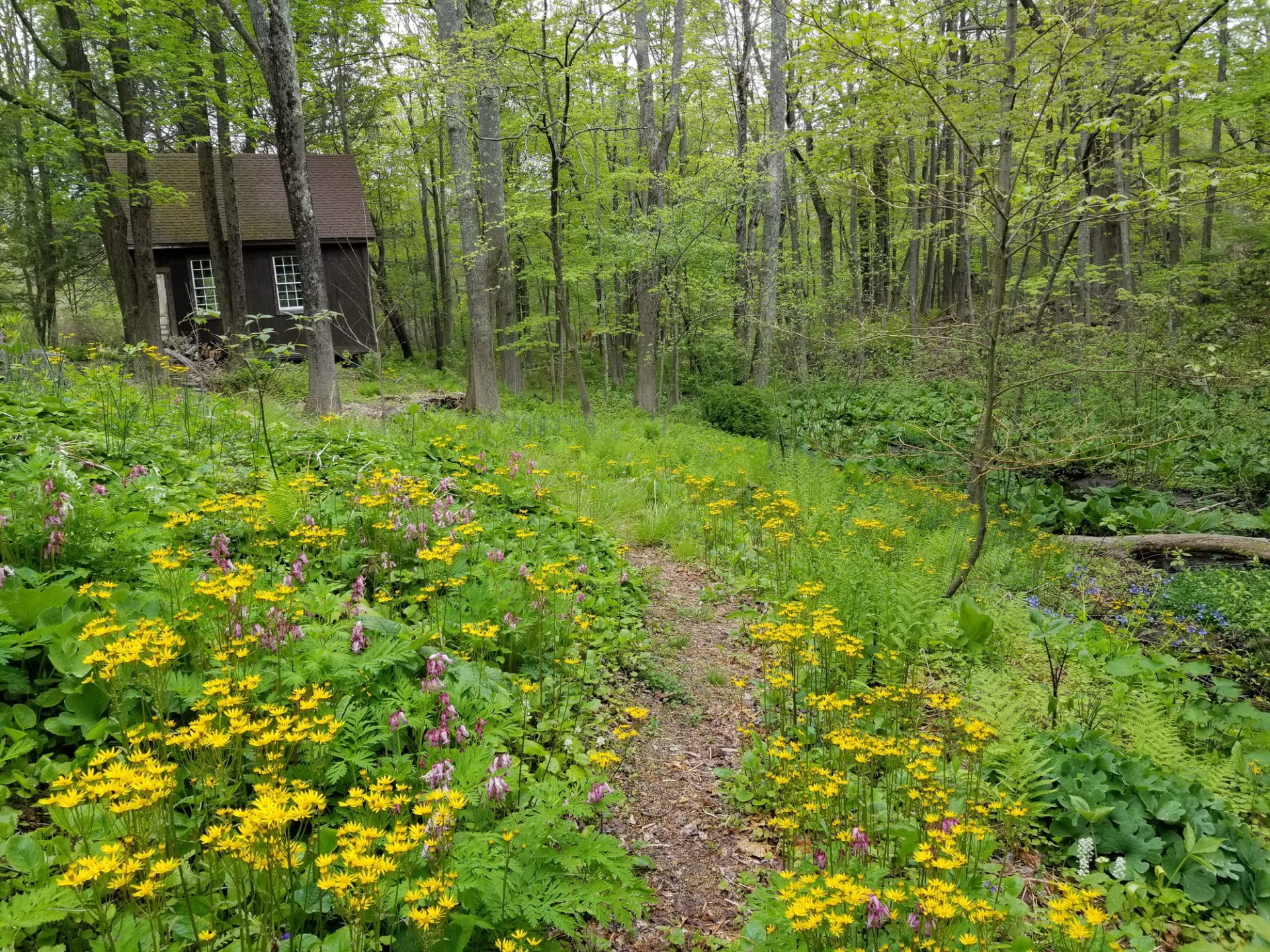
On the east side of the house, a narrow path meanders along a stream.
Beyond an arching pagoda dogwood, stone steps flanked by a bottlebrush buckeye lead away from the stream and back up the slope to the Sassafras Garden. A semi-circular stepping-stone path reaches around a sassafras tree, and a tall redtwig dogwood makes a strong statement. Wild bleeding heart, foamflower, wild ginger, flag iris, variegated Solomon seal, ferns, cranesbill, Pennsylvania sedge, and bloodroot elbow each other beneath their feet. Outside the path, sweet pepperbush, Virginia sweetspire, and dwarf inkberries hang out with barren strawberry, foamflower, and Pennsylvania sedge.
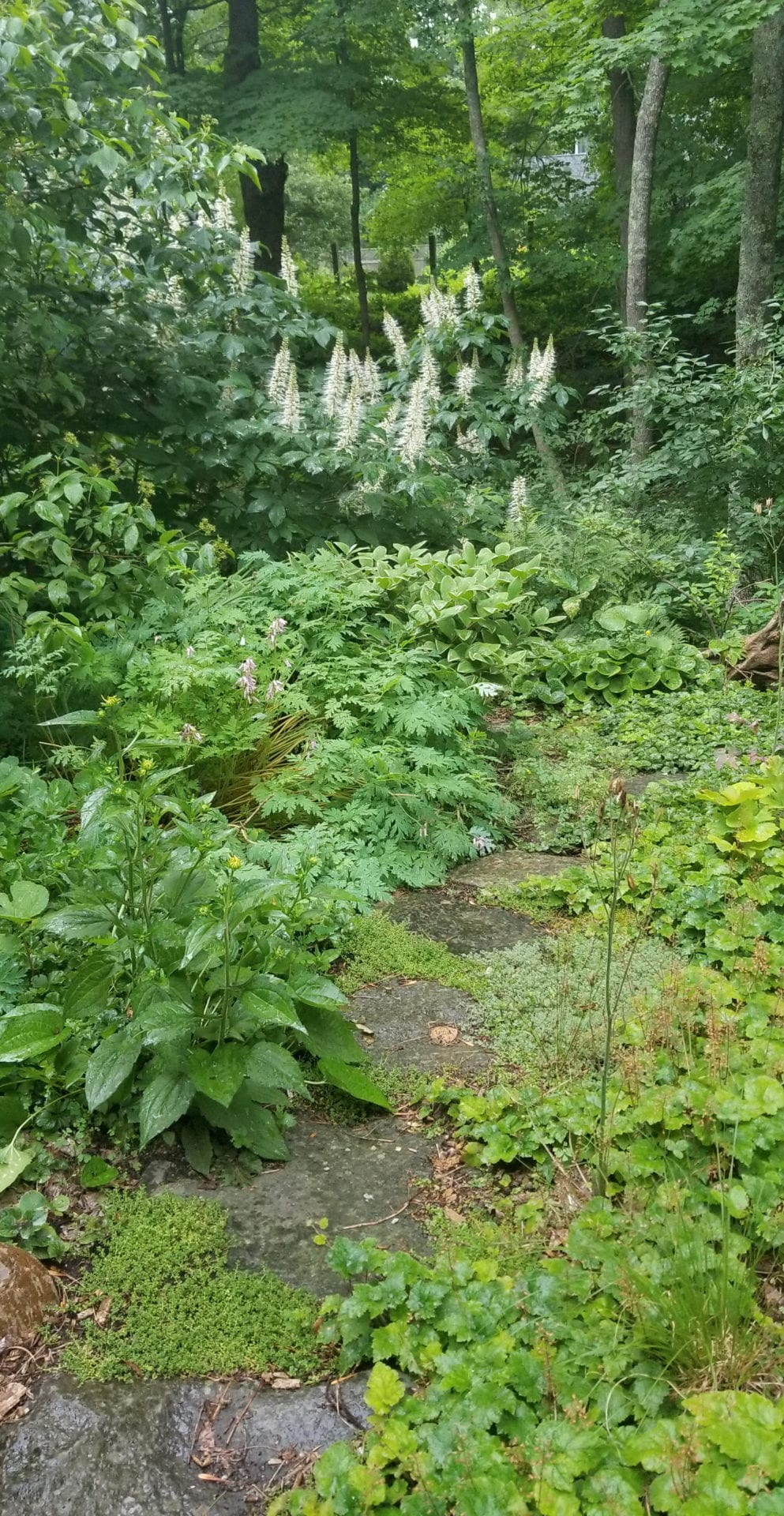
A stone path through the sassafras garden eventually leads to a new shade garden.
The stepping-stone path circles back to a stone dust walkway that stretches between the driveway and an old, half-size barn towards the rear of the property. Newly established groundcovers transplanted from the sassafras garden edge the path on the right, opposite the lawn. Beyond the sassafras garden, another shade garden is being established bit by bit within the open woodland, using the smothering technique. So far, hydrangea, flowering raspberry, leucothoe, mapleleaf viburnum, and gray dogwood have been introduced.
Naturalistic garden design brings a touch of wilderness to urban, suburban, and commercial settings by attracting a variety of birds, butterflies, pollinators, and other wildlife with a diversity of plant species. Planting thickly to fill the spaces, using groundcovers as green mulch, and leaving little soil exposed means far less time spent weeding or spreading bark mulch. Once established, native plant gardens require fewer inputs (fertilizer or water) which benefits the environment while saving on maintenance costs.
About the host
Nanette Masi is a nature-inspired landscape designer, photographer, writer, and educator. Her business, Back to Nature, creates sanctuary landscapes that soothe the soul and connect her clients to the natural world, integrating native and sustainable plant communities that bring beauty, bird song, and butterflies into their lives. With degrees in Botany, Ecology, and Education, and years of organic gardening and design experience, Nanette has been a guiding force in the creation of wildlife habitat gardens throughout the region. Nanette also brings seminars to life through her award-winning nature and landscape photography. She is a regular speaker for watershed groups, ecological landscaping organizations, schools, and gardening clubs.
***
Each author appearing herein retains original copyright. Right to reproduce or disseminate all material herein, including to Columbia University Library’s CAUSEWAY Project, is otherwise reserved by ELA. Please contact ELA for permission to reprint.
Mention of products is not intended to constitute an endorsement. Opinions expressed in this newsletter article do not necessarily represent those of ELA’s directors, staff, or members.


